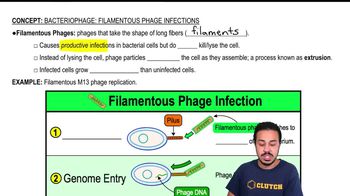NAME IT This virus family, normally associated with AIDS, may be useful for gene therapy.
Ch. 13 - Viruses, Viroids, and Prions
Chapter 10, Problem 13.1a
Place the following in the most likely order for biosynthesis of a bacteriophage: (1) phage lysozyme; (2) mRNA; (3) DNA; (4) viral proteins; (5) DNA polymerase.
a. 5, 4, 3, 2, 1
b. 1, 2, 3, 4, 5
c. 5, 3, 4, 2, 1
d. 3, 5, 2, 4, 1
e. 2, 5, 3, 4, 1
 Verified step by step guidance
Verified step by step guidance1
Identify the initial step in the biosynthesis of a bacteriophage, which typically involves the synthesis of mRNA from the viral DNA.
Determine the role of DNA polymerase, which is responsible for replicating the viral DNA.
Consider the synthesis of viral proteins, which are translated from the mRNA.
Recognize the function of phage lysozyme, which is involved in the later stages of the bacteriophage life cycle, aiding in the release of new virions.
Arrange the steps in a logical sequence based on the typical order of events in bacteriophage biosynthesis: mRNA synthesis, DNA replication, protein synthesis, and finally, the action of lysozyme.

Verified Solution
Video duration:
4mWas this helpful?
Key Concepts
Here are the essential concepts you must grasp in order to answer the question correctly.
Bacteriophage Life Cycle
Bacteriophages, or phages, are viruses that infect bacteria. Their life cycle typically involves attachment to a host cell, injection of viral DNA, and subsequent replication of viral components. Understanding the sequence of events in the life cycle is crucial for determining the order of biosynthesis processes, including the production of mRNA and proteins.
Recommended video:
Guided course

Krebs Cycle
Viral Replication and Transcription
During viral replication, the viral DNA is transcribed into mRNA, which serves as a template for synthesizing viral proteins. This process is facilitated by viral enzymes, such as DNA polymerase, which is essential for replicating the viral genome. Recognizing the roles of these components helps in understanding the correct sequence of biosynthesis.
Recommended video:
Guided course

Persistent Viral Infections
Role of Phage Lysozyme
Phage lysozyme is an enzyme produced by bacteriophages that helps in breaking down the bacterial cell wall, facilitating the release of new virions. It is typically one of the last steps in the phage life cycle, occurring after the viral components have been synthesized and assembled. Knowing when lysozyme acts in the process is key to ordering the steps of biosynthesis correctly.
Recommended video:
Guided course

Bacteriophage: Filamentous Phage Infections
Related Practice
Textbook Question
111
views
Textbook Question
Why do we classify viruses as obligatory intracellular parasites?
136
views
Textbook Question
Identify the viral family that infects skin, mucosa, and nerve cells; causes infections that can recur because of latency; and has polyhedral geometry.
111
views
Textbook Question
A viral species is not defined on the basis of the disease symptoms it causes. The best example of this is
a. polio.
b. rabies.
c. hepatitis.
d. chickenpox and shingles.
e. measles.
116
views
Textbook Question
List the four properties that define a virus. What is a virion?
117
views
Textbook Question
The molecule serving as mRNA can be incorporated in the newly synthesized virus
capsids of all of the following except
a. + strand RNA picornaviruses.
b. + strand RNA togaviruses.
c. strand RNA rhabdoviruses.
d. double-stranded RNA reoviruses.
e. Rotavirus.
81
views
